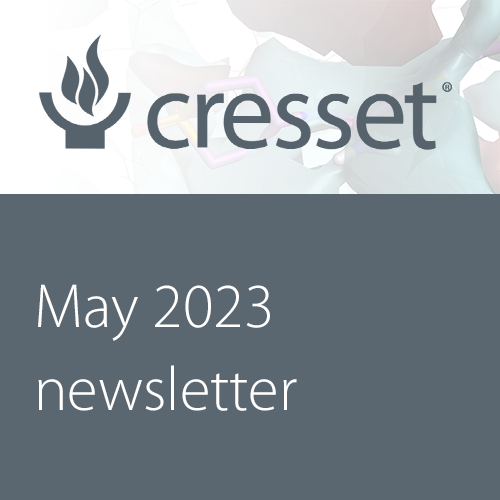Cresset's May 2023 Newsletter

Welcome to the May Cresset Newsletter
Explore some exciting new CADD and DMTA software updates, new science, upcoming events, and job openings in the latest monthly update from Cresset.
You can subscribe to our monthly newsletter list if you'd like to receive these monthly updates via email.
Flare V7 released: Access enhanced docking, better QSAR models and even more accurate FEP/ MD results
Our latest version of Flare, the workbench for ligand-based and structure-based modelling has arrived. This version 7 update is packed with new and enhanced scientific features and methods, to support both medicinal chemists and computational chemists with their drug discovery workflows.
New functionality includes enhanced sampling of hydration patterns through Grand Canonical Nonequilibrium Candidate Monte Carlo (GCNCMC) for molecular dynamics and Free Energy Perturbation (FEP) calculations, the new ensemble covalent docking method, QM semi-empirical calculations and Consensus models for building predictive QSAR models.
Parallel processing and a new calculations window enable users to launch and run multiple jobs within the same Flare project, which alongside GUI improvements such as a new ‘Search’ box, together, make the platform even more efficient, collaboration-friendly and simpler to use.
Identify novel and diverse compounds with fragment-based drug discovery
Fragment-based drug discovery (FBDD) is well-established as an effective method for advancing innovative drug design and has been adopted as a valuable technique for developing novel, diverse hits. However, morphing experimentally identified fragments with weak binding affinity into starting lead compounds can be challenging. Additionally, the protein target binding site may not be known, requiring identification and characterization of potential target binding pockets.
Learn more about these challenges in FBDD, and how medicinal chemistry experience and computational expertise play an essential role in growing and linking fragments to facilitate ligand design.
Engine Biosciences integrates Torx® into its drug discovery workflow
Engine Biosciences works at the innovative edge of integrating technology and drug discovery, to accelerate processes and reduce R&D costs for new and impactful therapies. The company has now integrated Torx® into its workflows to transform the way the team captures and shares knowledge.
“Using Torx, it is easy to identify any productivity bottlenecks, make quick and informed decisions about changes to priorities or assignments, and communicate these updates to team members and CROs.”
Toni Kline, Senior Director of Chemistry at Engine Biosciences
Read the case study to learn more.
Torx 2.0: Join our upcoming webinar to learn more about the latest updates
Torx is the only complete Design-Make-Test-Analyze (DMTA) solution on the market - capable of enabling huge efficiencies in your drug discovery workflow. The modular, cloud-native Torx platform enables chemistry teams to collaborate and share molecules, both internally and with contract research organizations (CROs) around the world.
Join us for an informative webinar on June 13th (4 pm BST/11 am EDT/8 am PDT) as we launch the latest software release of this revolutionary technology. Discover how Torx can optimize the entire molecule design, compound synthesis, testing and data analysis cycle.
Your partner for virtual screening
Different approaches to virtual screening return different hits. When developing a ligand-based template for virtual screening, Cresset Discovery’s CADD scientists apply their modeling expertise to define the best ‘hand-crafted’ estimate of a bioactive conformation. The same great care is given to exploring and preparing protein targets prior to structure-based virtual screens.
Using their insight and experience, our modelers choose the best technique, or combination of techniques, to fully understand the chemical system, provide comprehensive sampling of the available chemical space, and deliver an improved final list of candidate compounds.
Find out more about our approaches to virtual screening.
Allostery under the lens of molecular dynamics simulations
The Boston Area Group for Informatics and Modeling (BAGIM) is an active group of Boston area scientists bringing together people from the diverse fields of modeling and informatics to impact health and life sciences.
Last month, Professor Julien Michel, Professor of Biomolecular Simulation at The University of Edinburgh and member of Cresset’s Scientific Advisory Board presented at a Cresset-sponsored BAGIM virtual event. He discussed molecular dynamics (MD) simulation methodologies developed to interrogate protein conformational ensembles and provide insight into protein allostery. Catch up, via the session recording.
Save the date: Cresset User Group Meeting 2024
We're very excited to announce that the annual Cresset User Group Meeting is set to return in 2024. After a pandemic-enforced break over recent years, we’re delighted to invite Cresset software users and non-users once again, to hear Cresset scientists present our latest science and technology, supporting chemists across a full range of industries to design the very best molecules.
Stay tuned for further information, but for now, please mark your calendar with the following dates and venue information:
- 18th – 19th June 2024
- Renaissance Brussels Hotel, Belgium
Career Opportunities
Interested in working for a rapidly growing company, focused on helping organizations improve human health by developing better treatments for critical diseases?
Join our dedicated team of like-minded scientists, software developers, commercial specialists, and support staff, across a full variety of vacant roles.
Current open positions include Senior Web Developer, Scientific Software Developer C++, FP&A Analyst, HR Business Partner, and Senior Computational Chemistry Developer. Visit our careers page to find out more.





















